#IoT in Healthcare Market Trends
Explore tagged Tumblr posts
Text
https://www.abnewswire.com/pressreleases/iot-in-healthcare-market-growth-opportunities-business-scenario-share-growth-size-scope-key-segments-and-forecast-to-2028_697911.html
IoT-Powered Healthcare: Driving Efficiency and Patient Care
The rising penetration of smartphones, growing prevalence of chronic and lifestyle disorders, increasing healthcare costs, and rising self-health management leading to the increasing demand for better healthcare services will drive the market.
#IoT in Healthcare Market#IoT in Healthcare Market Size#IoT in Healthcare Market Share#IoT in Healthcare Market Trends#IoT in Healthcare Industry
0 notes
Text
IoT is utilized in the healthcare industry for data collecting, research analysis, and the monitoring of electronic health records containing protected health information, personally identifiable information, and other machine-generated patient records.
#iot in healthcare market forecast#iot in healthcare market growth#iot in healthcare market trends#iot in healthcare market analysis report
0 notes
Text
IoT in Healthcare Market to Hit $571.90 Billion by 2032
The global IoT in Healthcare Market was valued at USD 91.76 Billion in 2024 and it is estimated to garner USD 571.90 Billion by 2032 with a registered CAGR of 25.7% during the forecast period 2024 to 2032.
The report throws light on the competitive scenario of the global IoT in Healthcare Market to know the competition at global levels. Market experts also provided the outline of each leading player of the global IoT in Healthcare Market for the market, considering the key aspects such as the areas of operation, production, and product portfolio. In addition, the companies in the report are studied based on vital factors such as company size, market share, market growth, revenue, production volume, and profit.
The global IoT in Healthcare Market is fragmented with various key players. Some of the key players identified across the value chain of the global IoT in Healthcare Market include Cisco Systems Inc., Microsoft Corporation, IBM Corporation, SAP SE, Qualcomm Life, Inc., Honeywell Life Care Solutions, GE Healthcare, Siemens Healthineers, Medtronic, Philips, Honeywell Life Care Solutions, Boston Scientific, Johnson & Johnson, BIOTRONIK, Omron, AgaMatrix, STANLEY Healthcare, AliveCor, iHealth Lab, and Welch Allyn. etc. Considering the increasing demand from global markets various new entries are expected in the IoT in Healthcare Market at regional as well as global levels.
Download IoT in Healthcare Market Sample Report PDF: https://www.vantagemarketresearch.com/iot-in-healthcare-market-1232/request-sample
Top Competitors:
Cisco Systems Inc., Microsoft Corporation, IBM Corporation, SAP SE, Qualcomm Life, Inc., Honeywell Life Care Solutions, GE Healthcare, Siemens Healthineers, Medtronic, Philips, Honeywell Life Care Solutions, Boston Scientific, Johnson & Johnson, BIOTRONIK, Omron, AgaMatrix, STANLEY Healthcare, AliveCor, iHealth Lab, and Welch Allyn.
Understanding the Industry's Growth, has released an Updated report on the IoT in Healthcare Market. The report is mixed with crucial market insights that will support the clients to make the right business decisions. This research will help new players in the global IoT in Healthcare Market to sort out and study market needs, market size, and competition. The report provides information on the supply and market situation, the competitive situation and the challenges to the market growth, the market opportunities, and the threats faced by the major players.
Regional Analysis
-North America [United States, Canada, Mexico]
-South America [Brazil, Argentina, Columbia, Chile, Peru]
-Europe [Germany, UK, France, Italy, Russia, Spain, Netherlands, Turkey, Switzerland]
-Middle East & Africa [GCC, North Africa, South Africa]
-Asia-Pacific [China, Southeast Asia, India, Japan, Korea, Western Asia]
You Can Buy This Report From Here: https://www.vantagemarketresearch.com/buy-now/iot-in-healthcare-market-1232/0
Full Analysis Of The IoT in Healthcare Market:
Key findings and recommendations point to vital progressive industry trends in the global IoT in Healthcare Market, empowering players to improve effective long-term policies.
The report makes a full analysis of the factors driving the development of the market.
Analyzing the market opportunities for stakeholders by categorizing the high-growth divisions of the market.
Questions answered in the report
-Who are the top five players in the global IoT in Healthcare Market?
-How will the global IoT in Healthcare Market change in the next five years?
-Which product and application will take the lion's share of the global IoT in Healthcare Market?
-What are the drivers and restraints of the global IoT in Healthcare Market?
-Which regional market will show the highest growth?
-What will be the CAGR and size of the global IoT in Healthcare Market during the forecast period?
Read Full Research Report with [TOC] @ https://www.vantagemarketresearch.com/industry-report/iot-in-healthcare-market-1232
Reasons to Purchase this IoT in Healthcare Market Report:
-Analysis of the market outlook on current trends and SWOT analysis.
-The geographic and country level is designed to integrate the supply and demand organizations that drive industry growth.
-IoT in Healthcare Industry dynamics along with market growth opportunities in the coming years.
-IoT in Healthcare Market value (million USD) and volume (million units) data for each segment and sub-segment.
1 year consulting for analysts along with development data support in Excel. Competitive landscape including market share of major players along with various projects and strategies adopted by players in the last five years.
Market segmentation analysis including qualitative and quantitative analysis including the impact on financial and non-economic aspects.
Complete company profiles that include performance presentations, key financial overviews, current developments, SWOT analyzes and strategies used by major IoT in Healthcare Market players.
Check Out More Reports
Global Proteomics Market: Report Forecast by 2032
Global 3D Cell Culture Market: Report Forecast by 2032
Global Payment Orchestration Platform Market: Report Forecast by 2032
Global Cannabis Edibles Market: Report Forecast by 2032
Global Whey Protein Market: Report Forecast by 2032
#IoT in Healthcare Market#IoT in Healthcare Market 2024#Global IoT in Healthcare Market#IoT in Healthcare Market outlook#IoT in Healthcare Market Trend#IoT in Healthcare Market Size & Share#IoT in Healthcare Market Forecast#IoT in Healthcare Market Demand#IoT in Healthcare Market sales & price
0 notes
Link
0 notes
Link
Evolution of complementing technologies, such as Big Data and Artificial Intelligence drives the demand for an IoT (Internet of Things) in the healthcare...
0 notes
Link
The global Internet of Things (IoT) in healthcare market size is anticipated to reach over USD 169 billion by 2025.
0 notes
Text
5 Trends in ICT
Exploring the 5 ICT Trends Shaping the Future The Information and Communication Technology (ICT) landscape is evolving at a rapid pace, driven by advancements that are transforming how we live, work, and interact. Here are five key trends in ICT that are making a significant impact:
1. Convergence of Technologies
Technologies are merging into integrated systems, like smart devices that combine communication, media, and internet functions into one seamless tool. This trend enhances user experience and drives innovation across various sectors
Convergence technologies merge different systems, like smartphones combining communication and computing, smart homes using IoT, telemedicine linking healthcare with telecom, AR headsets overlaying digital on reality, and electric vehicles integrating AI and renewable energy.
2. Social Media
Social media platforms are central to modern communication and marketing, offering real-time interaction and advanced engagement tools. New features and analytics are making these platforms more powerful for personal and business use.
Social media examples linked to ICT trends include Facebook with cloud computing, TikTok using AI for personalized content, Instagram focusing on mobile technology, LinkedIn applying big data analytics, and YouTube leading in video streaming.
3. Mobile Technologies
Mobile technology is advancing with faster 5G networks and more sophisticated devices, transforming how we use smartphones and tablets. These improvements enable new applications and services, enhancing connectivity and user experiences.
Mobile technologies tied to ICT trends include 5G for high-speed connectivity, mobile payment apps in fintech, wearables linked to IoT, AR apps like Pokémon GO, and mobile cloud storage services like Google Drive.
4. Assistive Media
Assistive media technologies improve accessibility for people with disabilities, including tools like screen readers and voice recognition software. These innovations ensure that digital environments are navigable for everyone, promoting inclusivity.
Assistive media examples linked to ICT trends include screen readers for accessibility, AI-driven voice assistants, speech-to-text software using NLP, eye-tracking devices for HCI, and closed captioning on video platforms for digital media accessibility.
5. Cloud Computing
Cloud computing allows for scalable and flexible data storage and application hosting on remote servers. This trend supports software-as-a-service (SaaS) models and drives advancements in data analytics, cybersecurity, and collaborative tools.
Cloud computing examples related to ICT trends include AWS for IaaS, Google Drive for cloud storage, Microsoft Azure for PaaS, Salesforce for SaaS, and Dropbox for file synchronization.
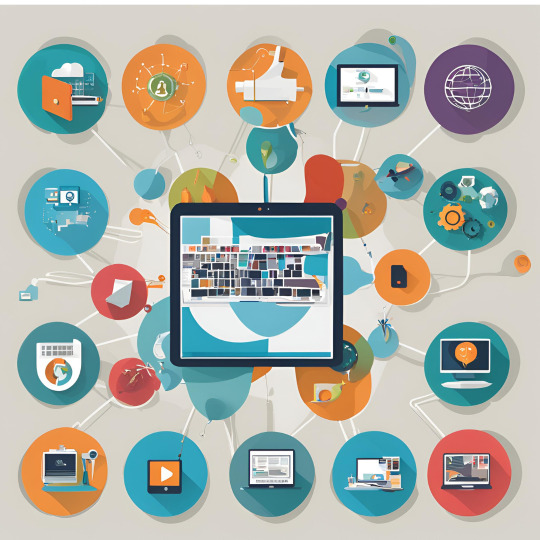
Submitted by: Van Dexter G. Tirado
3 notes
·
View notes
Text
Transforming the Health Landscape: The Global Blockchain in Healthcare Market
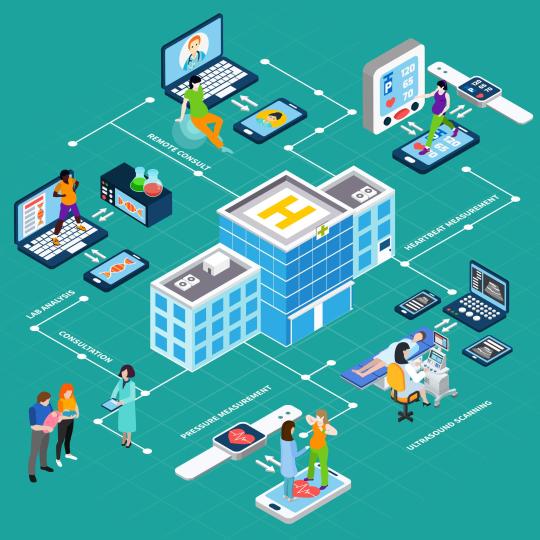
The integration of blockchain technology into the healthcare sector is revolutionizing the way medical data is managed, shared, and secured. As the demand for transparent, efficient, and secure healthcare services grows, blockchain offers promising solutions to longstanding challenges.
Understanding Blockchain in Healthcare
Blockchain Technology is a decentralized digital ledger that records transactions across multiple computers in a way that ensures the security and transparency of data. In healthcare, blockchain can be used to manage patient records, track pharmaceuticals, ensure the integrity of clinical trials, and streamline administrative processes. The immutable nature of blockchain helps in preventing data breaches, ensuring data accuracy, and enhancing patient privacy.
According to BIS Research, the Global Blockchain in Healthcare Market was estimated to grow to a value of $5.61 billion by 2025, and still the market is showing a steep growth till 2030 witnessing a double-digit CAGR growth rate throughout the forecast period.
Key Market Dynamics
Several factors are driving the growth of the global blockchain in healthcare market:
Data Security and Privacy:
Need for robust data security and privacy solutions.
Healthcare data breaches are a growing concern.
Blockchain's secure, immutable nature protects sensitive patient information.
Interoperability and Data Sharing:
Facilitates seamless data sharing between healthcare providers and systems.
Overcomes current interoperability issues.
Leads to better patient outcomes by providing a comprehensive view of health history.
Supply Chain Transparency:
Tracks the entire lifecycle of drugs in the pharmaceutical industry.
Ensures the authenticity of medications.
Helps combat counterfeit drugs.
Efficient Administrative Processes:
Streamlines various administrative processes, such as billing and claims management.
Reduces fraud and administrative costs.
Support from Regulatory Bodies:
Increasing support from regulatory bodies and governments.
Initiatives by FDA and EMA to explore blockchain for drug traceability and clinical trials boost market growth.
Request for an updated Research Report on Global Blockchain in Healthcare Market Research.
Global Blockchain in Healthcare Industry Segmentation
Segmentation by Application:
Data Exchange and Interoperability
Supply Chain Management
Claims Adjudication and Billing Management
Clinical Trials and Research
Others
Segmentation by End-User:
Healthcare Providers
Pharmaceutical Companies
Payers
Others
Segmentation by Region:
North America
Europe
Asia-Pacific
Latin America and Middle East & Africa
Future Market Prospects
The future of the global blockchain in healthcare market looks promising, with several trends likely to shape its trajectory:
Integration with AI and IoT: The integration of blockchain with artificial intelligence (AI) and the Internet of Things (IoT) will enhance data analytics, predictive healthcare, and real-time monitoring.
Expansion of Use Cases: New use cases for blockchain in digital healthcare will emerge, including patient-centered care models, personalized medicine, and enhanced telemedicine services.
Focus on Patient-Centric Solutions: Blockchain will enable more patient-centric healthcare solutions, empowering patients with greater control over their health data and enhancing patient engagement.
Development of Regulatory Frameworks: The establishment of clear regulatory frameworks and industry standards will facilitate the widespread adoption of blockchain in healthcare.
Conclusion
The Global Blockchain in Healthcare Industry is poised for significant growth, driven by the need for enhanced data security, interoperability, supply chain transparency, and efficient administrative processes. By addressing challenges related to regulatory compliance, implementation costs, standardization, and scalability, and leveraging opportunities in technological advancements, investments, partnerships, and government initiatives, the potential of blockchain in healthcare can be fully realized. This technology promises to revolutionize healthcare delivery, enhancing efficiency, transparency, and patient outcomes, and setting new standards for the future of digital health.
#Blockchain in Healthcare Market#Blockchain in Healthcare Industry#Blockchain in Healthcare Market Report#Blockchain in Healthcare Market Research#Blockchain in Healthcare Market Forecast#Blockchain in Healthcare Market Analysis#Blockchain in Healthcare Market Growth#BIS Research#Healthcare
2 notes
·
View notes
Text
The Transformative Impact of AI on Data Collection and Analysis
In the ever-evolving landscape of technology, Artificial Intelligence (AI) has emerged as a powerful force reshaping various industries. One of the areas experiencing a profound transformation is data collection and analysis. The integration of AI into these processes has not only increased efficiency but has also unlocked new possibilities for extracting meaningful insights. This article explores the ways in which AI is revolutionizing data collection and analysis, driving innovation across sectors.
Automation and Efficiency:
Traditionally, data collection involved manual efforts, consuming significant time and resources. AI has automated this process, enabling organizations to gather and process vast amounts of data at unprecedented speeds. Machine learning algorithms can sift through massive datasets, identifying patterns, trends, and anomalies far more efficiently than human counterparts. This not only reduces the burden on human labor but also allows organizations to make data-driven decisions in real-time.
Enhanced Accuracy and Predictive Analytics:
AI technologies, particularly machine learning, excel in recognizing complex patterns within data. This capability enhances the accuracy of data analysis and enables predictive analytics. By leveraging historical data, AI models can forecast future trends and outcomes, providing valuable insights for strategic decision-making. This predictive power is invaluable in industries such as finance, healthcare, and marketing, where accurate forecasting is crucial.
Natural Language Processing (NLP) for Unstructured Data:
With the proliferation of unstructured data in the form of text, audio, and video, traditional data analysis methods struggled to extract meaningful information. AI, specifically Natural Language Processing (NLP), has emerged as a game-changer in handling unstructured data. NLP enables machines to understand and interpret human language, making it possible to analyze text, sentiment, and context. This capability is particularly beneficial in customer feedback analysis, social media monitoring, and content categorization.
Internet of Things (IoT) Integration:
The rise of IoT devices has led to an explosion of data generated from various sources, ranging from smart appliances to industrial sensors. AI plays a pivotal role in processing and analyzing this data in real-time. Machine learning algorithms can identify patterns, detect anomalies, and optimize processes based on the continuous stream of IoT-generated data. This synergy between AI and IoT has significant implications for industries like manufacturing, logistics, and smart cities.
Personalization and Customer Insights:
AI-driven data analysis enables organizations to personalize user experiences by understanding individual preferences and behaviors. Through advanced recommendation systems and behavioral analysis, businesses can tailor their products and services to meet the specific needs of their customers. This level of personalization not only enhances customer satisfaction but also improves customer retention and loyalty.
Ethical Considerations and Privacy:
While AI has brought about unprecedented advancements in data collection and analysis, it also raises ethical concerns, particularly related to privacy. The vast amount of personal data being collected requires careful handling to ensure compliance with privacy regulations and to protect individuals' rights. Striking a balance between innovation and ethical considerations remains a critical challenge in the continued development of AI-powered data solutions.
Conclusion:
The integration of AI into data collection and analysis is revolutionizing the way organizations operate and make decisions. The increased efficiency, accuracy, and predictive capabilities offered by AI have far-reaching implications across various industries. As we navigate this transformative era, it is essential to address ethical considerations and privacy concerns to ensure responsible and sustainable use of AI technologies in the realm of data. The ongoing synergy between human intelligence and artificial intelligence promises a future where data-driven insights drive innovation and fuel progress.
To know more:
global market research company
developing a questionnaire for research
market research project management
2 notes
·
View notes
Text
Crafting Digital Transformation: The Expertise of a dApp Development Company
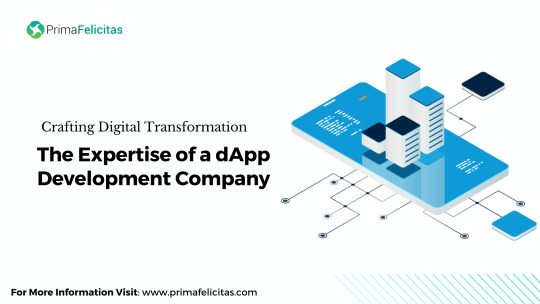
Digital transformation has become imperative for businesses navigating the ever-evolving technological landscape. Among the myriad tools and strategies, dApp development stands out as a pivotal means of crafting a seamless digital transformation experience. A reputable dApp development company plays a crucial role in guiding businesses through this intricate process.
Understanding dApp Development
Decentralized applications (dApps), a cornerstone of blockchain technology, offer transparency, security, and efficiency. The process involves designing, developing, and deploying these applications, harnessing the power of blockchain for a wide range of functionalities.
Choosing the Right dApp Development Company
Selecting the right partner for your digital transformation journey is paramount. Look for a dApp development company with a proven track record, relevant experience, and a portfolio that aligns with your business goals.
Services Offered by dApp Development Companies
These specialized firms provide a spectrum of services, including ideation, design, development, and deployment. They tailor solutions to the unique needs of each business, ensuring a customized and effective digital transformation.
Case Studies
Real-world case studies exemplify the impact of dApp development on businesses. These success stories illustrate how companies achieved enhanced efficiency, improved customer satisfaction, and significant growth through digital transformation.
Benefits of Investing in dApp Development
Investing in dApp development yields numerous benefits, including increased operational efficiency, streamlined processes, and elevated user experiences. These advantages contribute to a competitive edge in the market.
Challenges in dApp Development
While the benefits are substantial, challenges in dApp development exist. Addressing issues such as scalability, integration, and security is crucial for a successful digital transformation journey.
Future Trends in dApp Development
Staying abreast of emerging trends is essential. Technologies like artificial intelligence, Internet of Things (IoT), and smart contracts are shaping the future of dApp development. Adapting to these trends ensures the sustainability of digital solutions.
Client Testimonials
Client testimonials provide valuable insights into the practical impact of dApp development. Hearing directly from businesses that have undergone digital transformation showcases the tangible benefits of partnering with a reputable dApp development company.
Cost Considerations in dApp Development
Understanding the factors influencing the cost of dApp development helps in making informed decisions. Balancing quality and budget considerations ensures a cost-effective yet impactful digital transformation.
Security in dApp Development
Prioritizing security measures is non-negotiable. Robust security protocols safeguard dApps and the underlying blockchain infrastructure, ensuring data integrity and user trust.
Scalability of dApp Solutions
Planning for scalability is integral to future-proofing digital solutions. A well-designed dApp should seamlessly accommodate growth, adapting to the evolving needs of the business.
Industry-Specific dApp Solutions
Industries have unique requirements, and dApp development can be tailored to meet these specific needs. From healthcare to finance, examples abound of successful industry-focused dApp solutions.
Collaboration and Communication
Effective collaboration between businesses and dApp development teams is paramount. Transparent communication channels foster understanding, ensuring that the final product aligns with the client's vision.
Conclusion
In conclusion, a dApp development company serves as a guiding force in the digital transformation journey. From conceptualization to deployment, their expertise ensures a smooth transition, unlocking the full potential of decentralized applications. Businesses keen on embracing digital transformation should explore the services of reputable dApp development companies, paving the way for a future-ready and competitive enterprise.
FAQs
What is a dApp development company?
A dApp development company specializes in designing and deploying decentralized applications, leveraging blockchain technology for enhanced functionality.
How does digital transformation benefit businesses?
Digital transformation enhances operational efficiency, improves customer experiences, and provides a competitive advantage in the market.
What challenges are associated with dApp development?
Challenges include scalability, integration issues, and security concerns that require careful consideration and strategic solutions.
What industries can benefit from industry-specific dApp solutions?
Virtually any industry can benefit, including healthcare, finance, logistics, and more, with tailored dApp solutions addressing specific industry needs.
How can businesses ensure the security of their dApps?
Businesses can ensure security by implementing robust security protocols, conducting regular audits, and staying informed about the latest cybersecurity trends.
2 notes
·
View notes
Text
Unleashing the Power of Data Science: A Game-Changer in Today’s World

In the ever-evolving landscape of technology, data science has emerged as a pivotal force, reshaping the way we perceive and interact with the world around us. This transformative field goes beyond mere numbers; it is a dynamic fusion of mathematics, statistics, and computer science that unlocks unparalleled insights, fosters innovation, and influences the very fabric of our existence. Having knowledge of data science is important and to learn this we need a platform that provides us with full assistance . Uncodemy gives you that platform it provides the best data science course in Delhi.
Understanding the Impact of Data Science
Revolutionizing Decision-Making
Data science has become the linchpin of informed decision-making across various sectors. The ability to analyze vast datasets empowers organizations to make strategic choices backed by concrete evidence. From business strategies to healthcare policies, data-driven decision-making is steering us toward a future where precision and foresight reign supreme.
Fueling Technological Advancements
In the technological realm, data science serves as the catalyst for groundbreaking innovations. Machine learning algorithms, a subset of data science, enable computers to learn and adapt, leading to the creation of intelligent systems that continually refine their performance. This not only enhances efficiency but also opens new frontiers in areas like artificial intelligence and automation.
Shaping Personalized Experiences
The profound impact of data science extends to our daily lives, often in ways we may not consciously perceive. From personalized recommendations on streaming platforms to targeted advertising, data-driven algorithms tailor our digital experiences, creating a more customized and user-centric online environment.
The Role of Data Science in Global Challenges
Addressing Healthcare Dilemmas
In the healthcare sector, data science has become a beacon of hope. Through predictive analytics, it aids in disease detection and prevention. Moreover, analyzing patient data allows for the development of personalized treatment plans, ushering in a new era of precision medicine.
Tackling Environmental Issues
Data science proves to be a potent tool in addressing pressing environmental concerns. Through the analysis of climate data, it facilitates the identification of trends, enabling scientists and policymakers to devise effective strategies for mitigating the impact of climate change.
Enhancing Educational Strategies
In the realm of education, data science is transforming the way we approach learning. Adaptive learning platforms use data analytics to understand individual learning patterns, tailoring educational content to suit the unique needs of each student. This not only fosters better understanding but also enhances overall academic performance.
Data Science in Business: A Competitive Edge
Optimizing Operations
Businesses leveraging data science gain a competitive edge by optimizing their operations. From streamlining supply chains to predicting market trends, data-driven insights empower companies to stay agile and responsive in an ever-changing market landscape.
Customer-Centric Approaches
Understanding customer behavior is paramount in the business world, and data science plays a pivotal role in this domain. Customer analytics enable businesses to comprehend preferences, anticipate needs, and provide tailored solutions, fostering stronger customer relationships and brand loyalty.
The Future of Data Science: Unraveling Possibilities
Continued Integration with Emerging Technologies
As technology continues to advance, data science is expected to synergize with emerging technologies, creating new possibilities and pushing the boundaries of innovation. The integration of data science with the Internet of Things (IoT) and blockchain, for example, holds the promise of revolutionizing various industries.
Ethical Considerations and Data Privacy
With great power comes great responsibility. The ethical implications of data science cannot be overlooked. As it becomes more pervasive in our lives, ensuring data privacy and ethical use of information must be at the forefront of technological advancements.
Conclusion
In conclusion, data science stands as a formidable force, reshaping the world we live in. From influencing decision-making processes to addressing global challenges, its impact is profound and far-reaching. As businesses and industries continue to harness the power of data, the future holds exciting possibilities, with data science poised to be the cornerstone of innovation and progress.
Source Link: https://readnewsblog.com/unleashing-the-power-of-data-science-a-game-changer-in-todays-world/
3 notes
·
View notes
Text
Exploring the World of Data Analytics: Opportunities and Beyond
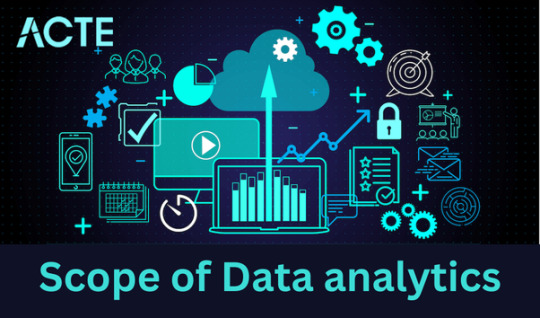
Describe data analytics. Analyzing data to find useful information, patterns, and trends is known as data analytics. Businesses adore it since it aids in their improvement. It’s similar to solving problems with data.
Why is data analysis so crucial? Consider yourself in possession of a treasure map (data) and the desire to locate the treasure (insights). Your compass is data analytics.
Why it matters is as follows: It aids in your understanding of consumer behavior, market trends, and company performance.
Efficiency: You can discover areas in which your company may save both time and money.Smart decisions: When using data, you may base decisions on facts rather than educated guesswork.
Personalization: Have you ever seen how Netflix suggests shows? That is data analysis.
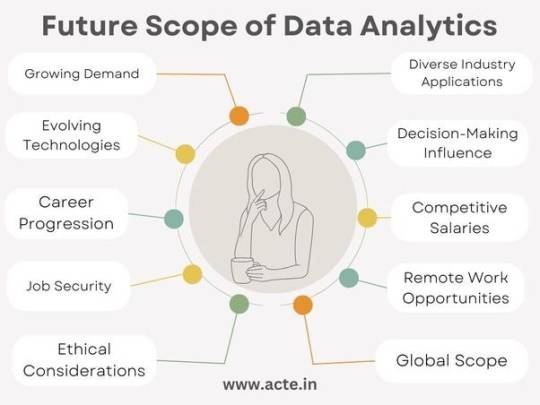
Future Scope of Data Analytics :
High Demand: Many businesses in different industries need data experts because they use data to make smart choices. So, the need for skilled data analysts is growing.
Various Job Fields: Data skills are useful everywhere, not just in one industry. You can work in finance, healthcare, e-commerce, marketing, or technology. This means you have many options for your career.
Tech Keeps Changing: The tools and methods for working with data keep getting better and different. It’s important to keep learning new things, but it also means you can become an expert in a special area.
Helping Decisions: Data people play a big role in helping businesses make important decisions. What you find in data can change how a company plans for the future.
Career Growth: Starting as a data analyst can lead to better and higher-paying jobs like data scientist or machine learning engineer.
Good Pay: Data analysts are paid well. As you get better at your job, you can earn even more.
Job Security: As long as companies use data, they’ll need people who understand it. So, you’ll have a stable job.
Work from Anywhere: You can often do data work from anywhere, giving you flexibility in where you live.
Ethical Data: Data privacy and being fair with data are important. People who can make sure data is used the right way are in demand.
Worldwide Opportunities: Data skills are needed all over the world, so you
can work in different countries if you want.
Careers in Data Analytics:
Data Analyst: The entry point They collect, clean, and analyze data.
Data Scientist: The Experts They use machine learning to solve complex puzzles.
Business Analyst: The bridge between data and business decisions
Big Data Engineer: They manage massive data sets using big data tools.
Healthcare Analyst: They use data to improve healthcare outcomes.
Marketing Analyst: Masters of measuring marketing success
Financial Analyst: They use data for financial strategies.
Sports Analyst: They play with data in the world of sports.
The Future of Data Analytics:
AI and machine learning: Think smarter, not harder. Automation will rule.
IoT Analytics: Connected devices will provide more data than ever.
Ethical Analytics: Data privacy will be a top concern.
Data Visualisation: Making data pretty and easy to understand will be big.

Feel free to get in touch with an ACTE institution if you want to learn more about Data Analytics because they provide certifications and possibilities for job placement. Teachers with experience can improve your learning. These services are available offline and online. Take things slowly and, if you’re interested, think about signing up for a course.
I hope I was able to effectively respond to your query. If it’s not, add it in the comments section. I still think I have a lot to learn.
Consider following me and giving this answer an upvote if you found it to be useful. This will motivate me to post more information on data analytics.
We appreciate you taking the time to read this and voting it up. Enjoy your day.
#data analytics#data analysis#data analytics course#data analyst jobs#data analyst training#data analyst certification#data analyst course
3 notes
·
View notes
Text
Revolutionizing Manufacturing: Top Trends to Watch in 2023

The manufacturing industry faced several challenges in 2022, including disruptions in the supply chain, transportation difficulties, worker shortages, and inflation. As a manufacturing company, it is essential to stay informed about the emerging industrial developments to prevent the issues that plagued the industry last year.
However, one thing we can tell you for sure is, having the right technology in place can bring you closer to gaining a competitive edge and adapting to the changing industry dynamics. To help manufacturing businesses gain this edge, we offer next generation SAP ERP solution.
What are some technological trends the manufacturing industry can expect in 2023?
Industry 4.0 and Digital Transformation
Industry 4.0 and digital transformation will continue to be major drivers of innovation in the manufacturing industry in 2023. With the rise of the Internet of Things (IoT), Artificial Intelligence (AI), and other advanced technologies, manufacturers will have unprecedented access to real-time data, which will enable them to optimize their operations and improve efficiency. By integrating digital technologies across the entire supply chain, manufacturers will be able to achieve greater flexibility, agility, and responsiveness to changing market demands.
Advanced Robotics and Automation
As the cost of robotics and automation technology continues to decrease, we can expect to see an increased adoption of these technologies in the manufacturing industry. Robotics and automation can help manufacturers reduce labor costs, improve quality and consistency, and increase productivity. With the advent of more advanced robotics and automation systems, we can expect to see greater levels of collaboration between human workers and robots, as well as the development of more complex and sophisticated automation systems.
Sustainability and Green Manufacturing
As the world becomes increasingly aware of the impact of climate change, sustainability and green manufacturing will become more important in 2023. Manufacturers will need to find ways to reduce their environmental impact, including the use of renewable energy sources, the reduction of waste and emissions, and the adoption of sustainable materials and processes. Customers are also becoming more conscious of their environmental impact, which means that manufacturers who prioritize sustainability will be more competitive in the marketplace.
Additive Manufacturing
Additive manufacturing, also known as 3D printing, is a rapidly growing technology that is changing the way manufacturers design, prototype, and produce products. In 2023, we can expect to see an increased adoption of additive manufacturing technologies, particularly in industries such as aerospace, healthcare, and automotive. With the ability to produce highly complex parts and components on-demand, additive manufacturing will enable manufacturers to achieve greater levels of customization and flexibility.
Reshoring and Nearshoring
The COVID-19 pandemic has highlighted the risks of global supply chains and the importance of resilience and agility in manufacturing. In 2023, we can expect to see more manufacturers exploring reshoring and nearshoring strategies to reduce their reliance on overseas suppliers and improve their ability to respond to changing market conditions. By bringing production closer to home, manufacturers can reduce lead times, improve quality control, and reduce transportation costs.
In conclusion, the manufacturing industry is set to undergo significant changes in 2023, driven by digital transformation, advanced robotics and automation, sustainability, additive manufacturing, and reshoring and nearshoring. Manufacturers who stay ahead of these trends will be better equipped to compete in an increasingly complex and competitive global marketplace.
If you want to transform your business by implementing latest solutions, get in touch with the team of Techscope Technologies.
Source: https://techscope.co.in/revolutionizing-manufacturing-top-trends-to-watch-in-2023/
3 notes
·
View notes
Text
Digital Twin Market Size 2023-2030: ABB, AVEVA Group plc, Dassault Systemes
Digital Twin Market by Power Source (Battery-Powered, hardwired with battery backup, Hardwired without battery backup), Type (Photoelectric Smoke Detectors, Ionization Smoke Detectors), Service, Distribution Channel, and region (North America, Europe, Asia-Pacific, Middle East, and Africa and South America). The global Digital Twin Market size is 11.12 billion USD in 2022 and is projected to reach a CAGR of 60.9% from 2023-2030.
Click Here For a Free Sample + Related Graphs of the Report at: https://www.delvens.com/get-free-sample/digital-twin-market-trends-forecast-till-2030
Digital twin technology has allowed businesses in end-use industries to generate digital equivalents of objects and systems across the product lifecycle. The potential use cases of digital twin technology have expanded rapidly over the years, anchored in the increasing trend of integration with internet-of-things (IoT) sensors. Coupled with AI and analytics, the capabilities of digital twins are enabling engineers to carry out simulations before a physical product is developed. As a result, digital twins are being deployed by manufacturing companies to shorten time-to-market. Additionally, digital twin technology is also showing its potential in optimizing maintenance costs and timelines, thus has attracted colossal interest among manufacturing stalwarts, notably in discrete manufacturing.
The shift to interconnected environments across industries is driving the demand for digital twin solutions across the world. Massive adoption of IoT is being witnessed, with over 41 billion connected IoT devices expected to be in use by 2030. For the successful implementation and functioning of IoT, increasing the throughput for every part or “thing” is necessary, which is made possible by digital twin technology. Since the behavior and performance of a system over its lifetime depend on its components, the demand for digital twin technology is increasing across the world for system improvement. The emergence of digitalization in manufacturing is driving the global digital twin market. Manufacturing units across the globe are investing in digitalization strategies to increase their operational efficiency, productivity, and accuracy. These digitalization solutions including digital twin are contributing to an increase in manufacturer responsiveness and agility through changing customer demands and market conditions.
On the other hand, there has been a wide implementation of digital technologies like artificial intelligence, IoT, clog, and big data which is increasing across the business units. The market solutions help in the integration of IoT sensors and technologies that help in the virtualization of the physical twin. The connectivity is growing and so are the associated risks like security, data protection, and regulations, alongside compliance.
During the COVID-19 pandemic, the use of digital twin technologies to manage industrial and manufacturing assets increased significantly across production facilities to mitigate the risks associated with the outbreak. Amid the lockdown, the U.S. implemented a National Digital Twin Program, which was expected to leverage the digital twin blueprint of major cities of the U.S. to improve smart city infrastructure and service delivery. The COVID-19 pandemic positively impacted the digital twin market demand for twin technology.
Delvens Industry Expert’s Standpoint
The use of solutions like digital twins is predicted to be fueled by the rapid uptake of 3D printing technology, rising demand for digital twins in the healthcare and pharmaceutical sectors, and the growing tendency for IoT solution adoption across multiple industries. With pre-analysis of the actual product, while it is still in the creation stage, digital twins technology helps to improve physical product design across the full product lifetime. Technology like digital twins can be of huge help to doctors and surgeons in the near future and hence, the market is expected to grow.
Market Portfolio

Key Findings
The enterprise segment is further segmented into Large Enterprises and Small & Medium Enterprises. Small & Medium Enterprises are expected to dominate the market during the forecast period. It is further expected to grow at the highest CAGR from 2023 to 2030.
The industry segment is further segmented into Automotive & Transportation, Energy & Utilities, Infrastructure, Healthcare, Aerospace, Oil & Gas, Telecommunications, Agriculture, Retail, and Other Industries. The automotive & transportation industry is expected to account for the largest share of the digital twin market during the forecast period. The growth can be attributed to the increasing usage of digital twins for designing, simulation, MRO (maintenance, repair, and overhaul), production, and after-service.
The market is also divided into various regions such as North America, Europe, Asia-Pacific, South America, and Middle East and Africa. North America is expected to hold the largest share of the digital twin market throughout the forecast period. North America is a major hub for technological innovations and an early adopter of digital twins and related technologies.
During the COVID-19 pandemic, the use of digital twin technologies to manage industrial and manufacturing assets increased significantly across production facilities to mitigate the risks associated with the outbreak. Amid the lockdown, the U.S. implemented a National Digital Twin Program, which was expected to leverage the digital twin blueprint of major cities of the U.S. to improve smart city infrastructure and service delivery. The COVID-19 pandemic positively impacted the digital twin market demand for twin technology.
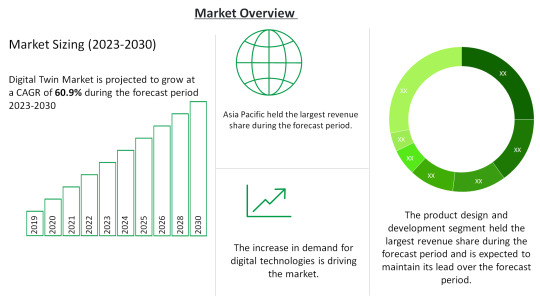
Regional Analysis
North America to Dominate the Market
North America is expected to hold the largest share of the digital twin market throughout the forecast period. North America is a major hub for technological innovations and an early adopter of digital twins and related technologies.
North America has an established ecosystem for digital twin practices and the presence of large automotive & transportation, aerospace, chemical, energy & utilities, and food & beverage companies in the US. These industries are replacing legacy systems with advanced solutions to improve performance efficiency and reduce overall operational costs, resulting in the growth of the digital twin technology market in this region.
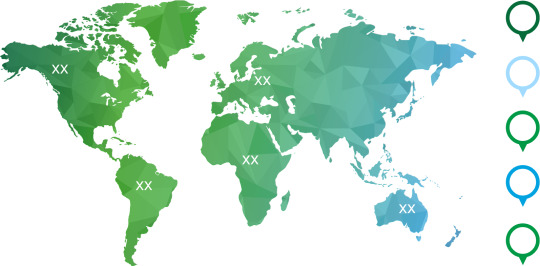
Competitive Landscape
ABB
AVEVA Group plc
Dassault Systemes
General Electric
Hexagon AB
IBM Corporation
SAP
Microsoft
Siemens
ANSYS
PTC
IBM
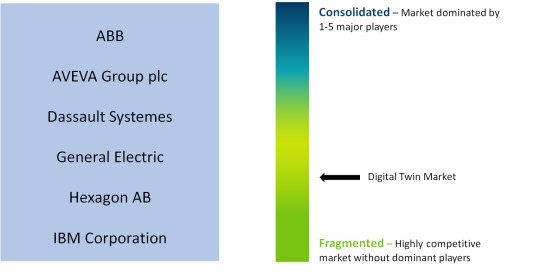
Recent Developments
In April 2022, GE Research (US) and GE Renewable Energy (France), subsidiaries of GE, collaborated and developed a cutting-edge artificial intelligence (AI)/machine learning (ML) technology that has the potential to save the worldwide wind industry billions of dollars in logistical expenses over the next decade. GE’s AI/ML tool uses a digital twin of the wind turbine logistics process to accurately predict and streamline logistics costs. Based on the current industry growth forecasts, AI/ML might enable a 10% decrease in logistics costs, representing a global cost saving to the wind sector of up to USD 2.6 billion annually by 2030.
In March 2022, Microsoft announced a strategic partnership with Newcrest. The mining business of Newcrest would adopt Azure as its preferred cloud provider globally, as well as work on digital twins and a sustainability data model. Both organizations are working together on projects, including the use of digital twins to improve operational performance and developing a high-impact sustainability data model.
Reasons to Acquire
Increase your understanding of the market for identifying the best and most suitable strategies and decisions on the basis of sales or revenue fluctuations in terms of volume and value, distribution chain analysis, market trends, and factors
Gain authentic and granular data access for Digital Twin Market so as to understand the trends and the factors involved in changing market situations
Qualitative and quantitative data utilization to discover arrays of future growth from the market trends of leaders to market visionaries and then recognize the significant areas to compete in the future
In-depth analysis of the changing trends of the market by visualizing the historic and forecast year growth patterns
Direct Purchase of Digital Twin Market Research Report at: https://www.delvens.com/checkout/digital-twin-market-trends-forecast-till-2030
Report Scope
Report FeatureDescriptionsGrowth RateCAGR of 60.9% during the forecasting period, 2023-2030Historical Data2019-2021Forecast Years2023-2030Base Year2022Units ConsideredRevenue in USD million and CAGR from 2023 to 2030Report Segmentationenterprise, platform, application, and region.Report AttributeMarket Revenue Sizing (Global, Regional and Country Level) Company Share Analysis, Market Dynamics, Company ProfilingRegional Level ScopeNorth America, Europe, Asia-Pacific, South America, and Middle East, and AfricaCountry Level ScopeU.S., Japan, Germany, U.K., China, India, Brazil, UAE, and South Africa (50+ Countries Across the Globe)Companies ProfiledABB; AVEVA Group plc; Dassault Systems; General Electric; Hexagon AB; IBM Corp.; SAP.Available CustomizationIn addition to the market data for Digital Twin Market, Delvens offers client-centric reports and customized according to the company’s specific demand and requirement.
TABLE OF CONTENTS
Large Enterprises
Small & Medium Enterprises
Product Design & Development
Predictive Maintenance
Business Optimization
Performance Monitoring
Inventory Management
Other Applications
Automotive & Transportation
Energy & Utilities
Infrastructure
Healthcare
Aerospace
Oil & Gas
Telecommunications
Agriculture
Retail
Other Industries.
Asia Pacific
North America
Europe
South America
Middle East & Africa
ABB
AVEVA Group plc
Dassault Systemes
General Electric
Hexagon AB
IBM Corporation
SAP
About Us:
Delvens is a strategic advisory and consulting company headquartered in New Delhi, India. The company holds expertise in providing syndicated research reports, customized research reports and consulting services. Delvens qualitative and quantitative data is highly utilized by each level from niche to major markets, serving more than 1K prominent companies by assuring to provide the information on country, regional and global business environment. We have a database for more than 45 industries in more than 115+ major countries globally.
Delvens database assists the clients by providing in-depth information in crucial business decisions. Delvens offers significant facts and figures across various industries namely Healthcare, IT & Telecom, Chemicals & Materials, Semiconductor & Electronics, Energy, Pharmaceutical, Consumer Goods & Services, Food & Beverages. Our company provides an exhaustive and comprehensive understanding of the business environment.
Contact Us:
UNIT NO. 2126, TOWER B, 21ST FLOOR ALPHATHUM SECTOR 90 NOIDA 201305, IN +44-20-8638-5055 [email protected] WEBSITE: https://delvens.com/
#Digital Twin Market#Digital Twin#Digital Twin Market Size#Digital Twin Market Share#Semiconductors & Electronics
2 notes
·
View notes
Text
Identity And Access Management Industry Development Trends Report By 2030
In 2022, the global identity and access management (IAM) market was valued at USD 15.93 billion, and it is projected to grow at a compound annual growth rate (CAGR) of 12.6% from 2023 to 2030. IAM solutions help organizations control and manage who has access to resources, ensuring that each employee and role within a company has appropriate permissions to perform their duties effectively. By implementing IAM systems, businesses can streamline the process of managing applications for employees, avoiding the need for administrators to individually log in to each app. The increasing integration of IoT, AI advancements, greater awareness of regulatory compliance, and widespread adoption of cloud technologies are key factors expected to fuel the growth of IAM over the forecast period.
With the rise in cybercrime and fraudulent activities, the need for secure and efficient IAM solutions has become more urgent. As organizations adopt cloud computing and embrace new technologies, IAM solutions are evolving to meet the demand for enhanced security. IAM systems use identity analytics and intelligence to monitor and flag unusual user account activities. These systems can identify and remove inactive accounts, detect any violations of company policies, and revoke access rights that are inappropriate for a user’s role. In this way, IAM solutions address enterprise security concerns and mitigate risks associated with unauthorized access.
The centralization that IAM provides is another driver for adoption. With IAM, companies can administer access rights across applications and manage authentication processes more efficiently, making tasks like signing up, signing in, and managing user credentials more streamlined for employees. This system of centralized control reduces costs associated with application management, as it provides reliable connectivity, standardizes processes, and implements user policies. IAM also ensures consistent identity verification and access protocols, enhancing user trust and reliability.
Gather more insights about the market drivers, restrains and growth of the Identity And Access Management Market
An important development in IAM is its integration with mobile device management (MDM) solutions. MDM enables companies to manage and control user access on mobile devices, which is crucial as employees increasingly rely on smartphones and tablets for work. MDM and IAM work together to enhance security across devices and safeguard user information. MDM can provision applications securely, complementing IAM’s authentication processes, so organizations maintain full control over device access while protecting data integrity. This synergy between IAM and MDM is critical, as it extends the security and control offered by IAM to mobile devices and supports the increased mobility needs of modern workplaces.
End-use Segmentation Insights:
IAM solutions serve a range of industries, including BFSI (banking, financial services, and insurance); energy, oil & gas; telecom & IT; education; healthcare; public sector & utilities; manufacturing; and others. In 2022, the public sector and utilities segment held the largest revenue share, accounting for over 25% of the market. This segment’s growth is driven by increased digitalization efforts within the public sector, substantial investments in digital applications, and the management of large amounts of public data. As public entities adopt digital processes, they require IAM solutions to ensure secure access to sensitive data, making IAM critical in safeguarding public sector information systems.
The BFSI segment is expected to witness the fastest growth over the forecast period. As online transactions, e-wallets, and digital banking become increasingly popular, the BFSI industry is adopting IAM solutions to secure access rights, minimize security risks, and comply with regulatory standards. IAM provides this sector with the ability to authenticate users, control access to financial data, and protect customers from fraud. As financial services become more digitally driven, IAM systems help safeguard sensitive data and manage risks associated with unauthorized access to financial resources.
Other sectors, including manufacturing, education, IT & telecom, retail & consumer packaged goods, and energy & utilities, are also expected to experience significant growth in IAM adoption. For instance, the manufacturing sector uses IAM to control access to proprietary data and manage IoT-enabled equipment securely. The education sector benefits from IAM by managing secure access to educational resources and student data, while IT & telecom companies rely on IAM to control data access across complex, large-scale infrastructures. Similarly, energy and utility companies adopt IAM to safeguard critical infrastructure, managing employee access and monitoring systems to prevent unauthorized access.
In summary, the IAM market is growing rapidly as organizations across industries increasingly rely on IAM to protect data, ensure regulatory compliance, and optimize access control. The integration of IAM with emerging technologies like AI, IoT, and cloud computing is enhancing the scope of IAM solutions, making them essential for secure digital transformation. Despite challenges such as high implementation costs and the complexity of integrating IAM with existing systems, the expanding need for data security, particularly in public and BFSI sectors, is expected to drive sustained growth in the IAM market.
Order a free sample PDF of the Identity And Access Management Market Intelligence Study, published by Grand View Research.
0 notes
Link
Evolution of complementing technologies, such as Big Data and Artificial Intelligence drives the demand for an IoT (Internet of Things) in the healthcare...
0 notes